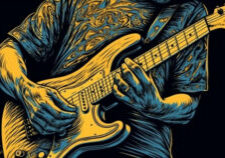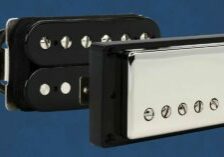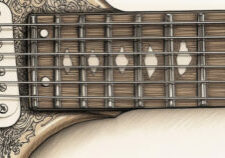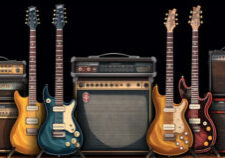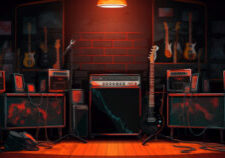Guitarists use two common types of amps: the tube amp and the more affordable solid-state amp. Tube amps were used to amplify electric guitars from the beginning. They are the most popular type of amp even to this day. They are highly sought after by guitarists for their luscious sound, sparkling cleans, and smooth yet powerful distortion tones. So it’s no surprise that the most popular, the most recorded and most played amps in history are indeed tube amps.
Solid-state amps have been around since the 1960s and even though amp companies can make solid-state amps for a really low price, they just do not have the same sound quality as a tube amp. Still, amp companies were making solid-state amps as they were generally in demand by new guitar players or those on a budget. They have always been fantastic for home practice amps. Solid-state amps are rarely been used by professional musicians for live gigs or recording until about 10 years ago. That is when amp modeling started getting a lot better.
Nowadays, most of the popular solid-state amps come with modeling technology. In this article, we’ll take a deeper dive into the pros and cons of tube amps vs. modeling amps. And we’ll discuss some of the advancements of modeling amps and how the future is likely to unfold.
Tube Amp Basics
Tube amps, also known as valve amps, are a type of guitar amplifier that uses vacuum tubes to amplify the signal from the guitar. These vacuum tubes are responsible for the unique sound and characteristics that tube amps are known for.
In a tube amp, the signal from the guitar passes through the preamp tubes, which shape and amplify the signal, and then through the power tubes, which further amplify the signal to drive the speakers.
Using vacuum tubes in tube amps results in a warm, natural, and dynamic tone that many guitarists prefer. Tube amps are also known for their responsiveness to the player’s touch and how they interact with the guitar’s pickups.
Modeling Amps
In the 1990’s, the next evolution of the solid-state amp was introduced. Since the amp companies couldn’t make a solid-state amp with the amazing tone of a tube amp, they started trying to match the tone f these amps using software. This is how “digital modeling” was born. Digital modeling amps add digital hardware and software that makes the solid-state amp sound like a tube amp.
Modeling amps work by converting received signals into binary code through terminals and an internal computer. Most modeling amps provide onboard effects like chorus and reverb, eliminating the need for external pedals. Modeling amps are known for their versatility and affordability, making them a popular choice for practice and experimentation.
Sound of Modeling Amp vs. Tube Amps
In terms of sound, modeling amps use digital signals, which can sometimes sound artificial. This has always been the biggest knock, but this is something that keeps improving.
Tube amps produce a natural and rounded sound that many guitarists prefer. Tube amps are commonly used for live performances because they deliver powerful and dynamic tones.
Tube Amp Appeal
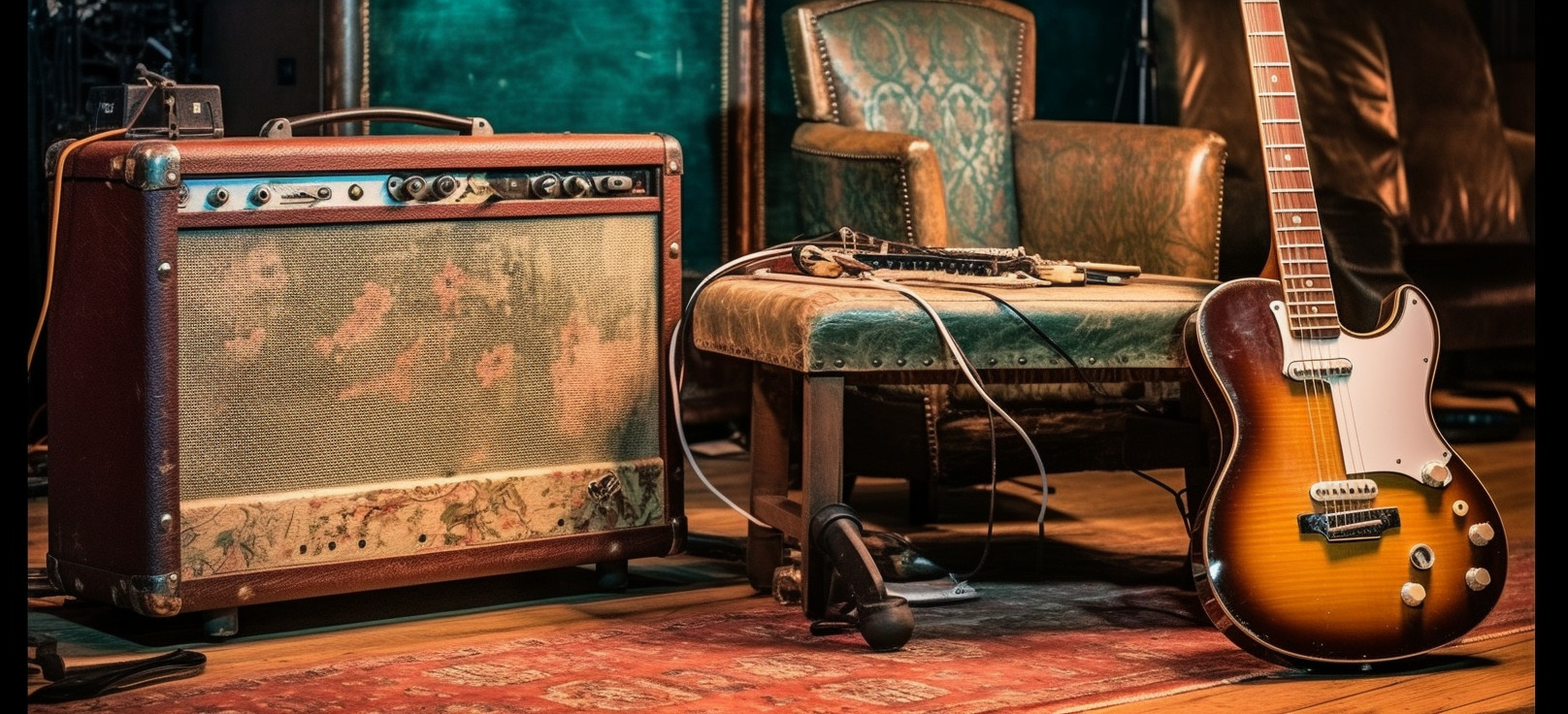
If we go back to the beginning of rock and roll music, all of our idols were playing electric guitar using tube amps. In the 1950’s through 1970’s, most bands were playing the legendary Fender Twin Reverb or the Marshall Super Lead also known as a Plexi. These amps have a unique sound that you just cannot replicate with a solid-state amp.
If you’re a guitarist who values warmth and depth in your tone, you’ll appreciate the appeal of tube amps. Tube amps have a unique ability to produce a rich, organic sound that is highly sought after by many musicians. The key to this appeal lies in the design and operation of tube amps.
Tubes produce a natural distortion that adds character and depth to the sound. How the tubes respond to the input signal and interact with the other components of the amp contributes to the overall tonal quality. This interaction creates a dynamic and responsive playing experience that is difficult to replicate with digital modeling.
Another aspect of the appeal of tube amps is their ability to be customized and modified. Tube amps allow for various adjustments, such as swapping out different types of tubes, adding effects loops, or adjusting the bias of the tubes. These modifications can further enhance the tonal characteristics of the amp, allowing guitarists to tailor their sound to their preferences.
In addition to their unique sound and customization options, tube amps are also known for their durability and reliability. While they do require regular maintenance, such as replacing tubes, tube amps are generally well-built and can withstand the rigors of live performances. This reliability and exceptional sound quality are the big reasons most people still use tube amps despite advancements in digital modeling.
Digital Modeling Versatility
The versatility of digital modeling allows you, as a guitarist, to explore a wide range of amp and effect simulations. With digital modeling, you have the ability to easily switch between different amp sounds, giving you the flexibility to experiment and find the perfect tone for any genre or playing style. Whether you’re looking for the warm and smooth tones of a vintage tube amp or the aggressive and high-gain sounds of a modern metal amp, digital modeling can accurately replicate the sound of various tube amps, providing you with endless possibilities.
Not only does digital modeling allow you to explore different amp sounds, but it also offers a plethora of effect simulations. From classic modulation effects like chorus and flanger to time-based effects like delay and reverb, digital modeling gives you access to a wide variety of effects that can enhance your playing and add depth and dimension to your sound.
In addition to its versatility, digital modeling is often used in recording studios for its flexibility. It allows you to easily capture different amp and effect combinations, making it a valuable tool for recording engineers and producers. Furthermore, digital modeling can be a cost-effective solution for guitarists, as it eliminates the need to invest in multiple amps and effects pedals.
Digital Modeling Advancements
Over the years, digital modeling has undergone significant improvements, addressing many of the concerns that guitarists once had.
One notable advancement is the enhanced realism in amp and effect simulations. Digital modeling technology has become increasingly adept at replicating the sound and characteristics of various tube amps. With more accurate modeling algorithms and higher processing power, modern digital modeling units can convincingly emulate the warmth, depth, and dynamic response associated with tube amps. This means that guitarists can now enjoy a wide range of amp sounds without the need for multiple physical amplifiers.
Furthermore, digital modeling has found its place in recording studios, thanks to its flexibility. Engineers appreciate the ability to easily switch between different amp and effect simulations, allowing for a streamlined workflow and quick experimentation. Additionally, digital modeling offers a cost-effective solution for guitarists who desire a wide variety of tones without the financial burden of purchasing multiple tube amps.
The High End Digital Modeling Amps
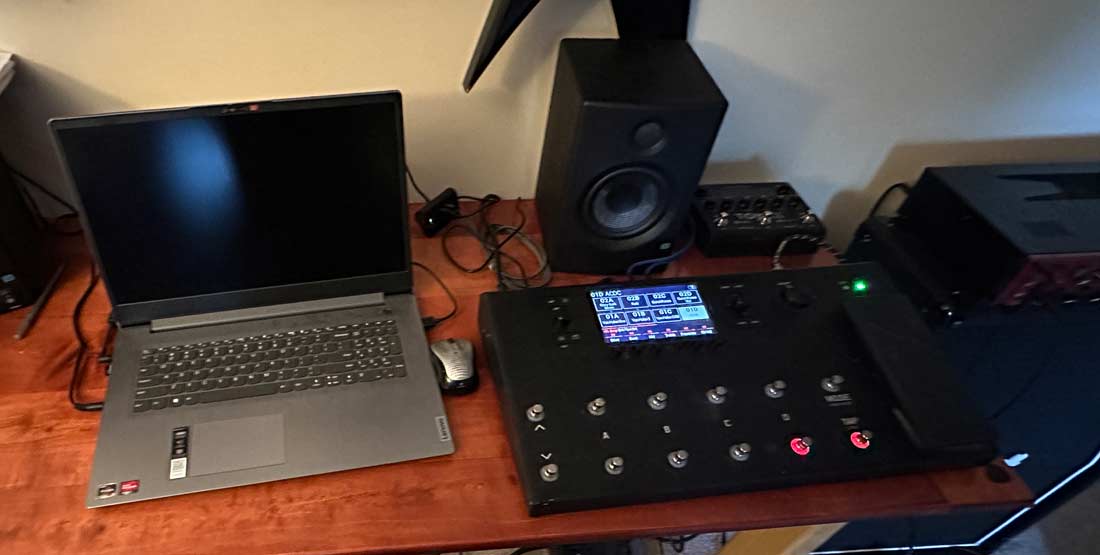
Desk in my bedroom with my laptop and the Line 6 Helix LT modeling amp
Around 2010, some new modeling amps were released and exhibited a big step up in quality. A new line of companies started developing modeling technology. At the same time, PC-based computer modeling, effects and amp simulators (amp sims) were becoming more popular. Companies like Neural DSP, came onto the scene in 2017 to become one of the leaders in amp modeling technology.
In 2015, Line 6 introduced the Helix line of floor modelers. While a few other modelers (like the Kemper Profile) existed, this was the first big brand to offer modeling software that started to nail the sound of tube amps. I own a Line 6 Helix LT that you see in this photo and it’s outstanding. I had owned other modeling amps and devices in the past, but this one is superior.
The amp models sound fantastic. The software constantly gets upgraded making it better and better. In the past year, they upgraded their amp models and the speaker cabinet models. The biggest knock on the Helix was that the cabs were only OK. Their recent cab models are fantastic and while I still use IR’s, its much easier to just grab one of their factory preset cabs, especially when you are setting up new presets.
Line 6, Kemper, Fractal Audio, Neural DSP, Boss, and NUX are major players in this game. consistently creating new modeling software and getting closer to fully replicating the legendary tones of my favorite amps. I still love a tube amp, so I will always own a few, but when I play covers or want to record, it’s much nicer to hop on the Helix.
Frequently Asked Questions
What are the advantages of using a tube amp over a modeling amp?
Tube amps offer a warmer tone, authentic feel, and a unique dynamic response that no modeling amp can match. It’s like comparing a fine wine to boxed grape juice. So, if you value true tone and a genuine playing experience, tube amps are the way to go.
Are tube amps more expensive than modeling amps?
Most high-quality tube amps are more expensive than modeling amps. However, the high-end modeling amps aren’t cheap. The cost of both types of amps can vary depending on factors such as brand, features, and overall quality. It is possible to find affordable tube amps and more expensive modeling amps.
Can modeling amps replicate the sound of different types of tube amps?
The best modeling amps can replicate the sound of different tube amps. Sometimes, these amps don’t have the dynamics or feel of a tube amp, but often, you can record modeling amps and sound just like the tube amp it’s modeled after, and it would be very hard for anyone to tell.
Do tube amps require regular maintenance?
Tube amps do require regular maintenance to ensure optimal performance. This includes replacing tubes every 6 to 12 months and periodic cleaning and adjustments. Regular maintenance is essential for maintaining the longevity and reliability of tube amps.
How has digital modeling technology improved in recent years?
Digital modeling technology has recently improved by offering more realistic amp and effect simulations. This includes advancements in capturing the nuances and subtleties of tube amps, resulting in a more authentic and satisfying playing experience for guitarists.
Conclusion: Tube & Modeling Amps
The difference between tube amps and modeling amps is quite stark, but both of them provide enough value to be a viable tool for the modern guitarist. Which one you go with comes down to personal preference and individual needs.
Tube amps offer this natural tone that is hard to replace. Tube amps have a “feel” that’s hard to explain. I love plugging into one of my tube amps, and 4×12 cabs load up some high gain and start cranking out some tunes. I can feel that thump that hits you right in the chest. It’s something You can thump in your chest. You feel the dynamics. When I’m plugged into one of my tube amps and run it through one of my 4×12 cabs and turn up the volume, I get that smooth. It’s much easier for musicians to find their own sound with a tube amp.
Modeling amps are affordable and versatile, like a Swiss Army knife, offering a wide range of effects and tones. While they may lack the organic feel of tube amps, the tech keeps improving. Today, the high-end modeling amps sound great and are getting close to the quality of a tube amp.
Ultimately, the choice between tube amps and modeling amps depends on your desired sound, budget, and performance requirements. Or you can be like me and own both!

